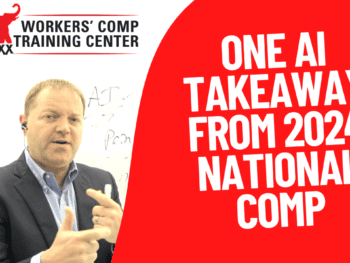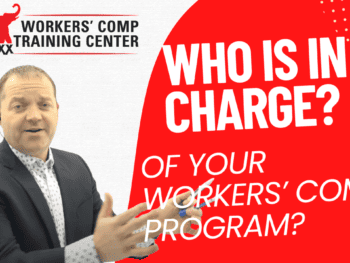Hello, Michael Stack here with Amaxx. So, it was another very successful National Work Comp and Disability Conference last week in Las Vegas, it was a very active expo, the parties of course were always a great time, and the attendance was up 10%.
But, the thing I got out the most were some very informative sessions. I’m going to go over my top 5 take-aways from the sessions that I attended and the notes that I took. My favorite session was called Steal These Ideas: Teddy Awarding Winning Employers Share Their Successes.
Management Commitment
And the first point that I took out was in regards to management commitment. These were all programs that had significant turn arounds from where they were in their work comp programs; significant savings, lost time claims down, just overall improvement in their programs. Carol Russo is the risk manager for Barnabus Health. She implemented a program, they are a large employer, they have over 21,000 employees, and I believe over 10 facilities. She recommended starting small, so they started their program in just one hospital, they were able to get some systems in place, they were able to get a program in place, and they were able to start seeing results. With the results in that small pilot program there were able to roll it out into the rest of the company, and there were able to get buy-in from the senior management of the organization because they had a repeatable system and they could demonstrate the savings and the positive outcomes they were achieving.
After that, they started the roll out, she mentioned, they were only looking at their work comp metrics once / year, they were only looking it annually, which is pretty common among most organizations. They started doing these monthly metrics, so as they’re rolling this out, they are getting these demonstrable results, and now you are looking at these results and demonstrating to senior management on a monthly basis so you can build that momentum and get that buy-in from the rest of the company. One other point that was made here in regards to management commitment was you need to anticipate the questions, anticipate the problems that are going to happen, so you can have answers ready. So, that was point number one.
Communication
Point number 2 actually came from that same session and it was in regards to communication. Jennifer Saddy is the risk manager at American Airlines, and recently American Airlines and US Air merged, so two huge companies coming together, the results that she has been able to achieve have been pretty incredible, as a merged organization, the two companies coming together, they are paying less now in workers comp then they were as an American Airlines company before the merger. So, pretty significant results. What she said was one of the biggest and most significant changes she made was she changed the role of her team members. So, prior to this, her being involved, all the communication was coming from the corporate level. So, coming off as fairly cold, they didn’t’ know these people, no relationship, oftentimes weren’t in the same state, or even the same region as this person.
So, the communication was very cold, she changed that so the main communication went down to the supervisor level, so changed from a cold corporate communication to a very personal supervisor relationship that knows the employees, probably knows their family, maybe knows their kids, and can really make this person interactive with the injured worker on getting them to buy in to what the company was trying to do in getting them back to work and really that element of care was much easier to demonstrate. So, she said that change was one of the most significant changes that they made, and really made the most significant impact on their organization.
Weekly Calls
So, third point came from that same session, it was really a lot of good points that came out of this session, and a number of the panelists agreed on this point that is was something they were doing. From a communication standpoint, from a company level, this is communication standpoint from the program level. You have your broker, your risk manager, and your account executive all getting together on a weekly call, to review claims, review claim files, and have an action plan to get these claims closed. This keeps all parties accountable, and it keeps all partied involved in this process. Implementing these weekly calls, there were about 2-3 panelists that mentioned there were doing this, so I pulled it out as a very significant point that they were doing to really achieve these significant results.
So, weekly calls was the third point there, and one of the things they said, and I forget exactly who said this, but she said “obviously, we are all very involved employers”, which I thought was such a great statement, because it just speaks to how important it is to have the employer involved.
Early Claim Intervention
Alright, so fourth point here, in regards to early claim intervention, talked a lot about injury triage, and of course we are huge believers in injury triage and working with a best in class provider. But, the point I took out of here was using the ‘% of claims reported within 1 day’ as a leading indicator, so we talk about how important it is to report the claim, a lot of studies, statement, and articles about this. But, what I took out of these was using this as a leading indicator, meaning all the supervisors know this number, all the senior management know this number, all the important stakeholders know this number on a regular basis, on a weekly, monthly, quarterly, annual basis. This is a number that is being tracked and this is a number that is being known. The research that they have seen is the better they do with this number, the better they do overall with their program goal. I think we get so inundated with data that we need to just boil it down to one number that we can hold onto, and this is the number there were holding onto in their program.
Pre-Work Screening
Last point here is in regards to Pre-Work Screening. So, another problem we see a lot in regards to pre-hire screening is they say, “well, we just need to get bodies we have a low paying wage, maybe it’s not the most attractive job, we just need to get people in there, so we really can’t afford to screen anyone out. “ What I took out of this was really an answer to that problem, was just lower that standard. You need to continue to do pre-hire screening, because you might just be hiring that next work comp claim. Maybe the standard for your ideal candidate is 100, but based on your testing and based on your need to get people in there, maybe you have to lower that standard down to 70, or maybe even 50, or maybe even 20 in order to get the required amount of people in there. The point is you still have a standard, maybe it is just a little bit lower, but you are doing this screening process and you are screening out the worst of the worst, the ones that are almost guaranteed to file a work comp claims immediately after hire. So, that is a great answer that I pulled out of that session In regards to pre-hire screening and the need to get people in the seats.
So, it really was a very informative, I have a ton of notes that I took out, these are just a couple of the points I thought were most interesting. Next year’s program is out in New Orleans, so I hope to see you out there.
Remember, in workers comp, your success is based on your integrity, so be great!
Author Michael Stack, Principal, COMPClub, Amaxx LLC. He is an expert in workers compensation cost containment systems and helps employers reduce their work comp costs by 20% to 50%. He works as a consultant to large and mid-market clients, is co-author of Your Ultimate Guide To Mastering Workers Comp Costs, a comprehensive step-by-step manual of cost containment strategies based on hands-on field experience, and founder of COMPClub, an exclusive member training program on workers compensation cost containment best practices. Through these platforms he is in the trenches on a monthly basis working together with clients to implement and define best practices, which allows him to continuously be at the forefront of innovation and thought leadership in workers’ compensation cost containment. Contact: mstack@reduceyourworkerscomp.com.
©2015 Amaxx LLC. All rights reserved under International Copyright Law.
Do not use this information without independent verification. All state laws vary. You should consult with your insurance broker, attorney, or qualified professional.















You are right John, it does take some work. However, it’s all about eating the elephant one bite at a time.
Thank you,
I appreciate the presentation, The White Board helps me follow the subject you are outlining. To tackle the possible problems that size company would have, would require some serious effort by the staff. And to put in and manage a Model that could be used by the Variety areas, you would need to put together a plan removing the petitions between departments.
I am some what familiar with this type Model.
Experience: Resident Associate Manager, Marshall Islands: Army Red Stone Missile Range, and Vandenburg AF Missile recovery. Covering operations , Johnson Islands and Eniwetok, Departments
Diving operations, ,Fire Dept, and Security. Lots of different operations and contractors, Primary
Contractor Global Associates International.